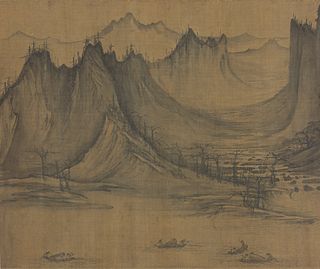Related Research Articles

Wen Tong (1019–1079) was a Northern Song painter born in Sichuan famous for his ink bamboo paintings. He was one of the paragons of "scholar's painting", which idealised spontaneity and painting without financial reward.

Zhan Ziqian was a famous painter of ancient China from Yangxin County in modern-day Shandong province. His birth and death dates are unknown. It is known that in the Sui dynasty (581–618) he was appointed to the office of Chaosan Dafu (朝散大夫) and later of Zhangnei Dudu (帐内都督).
The Four Wangs were four Chinese landscape painters during the Qing dynasty in the 17th century, all with the surname Wang. They are best known for their accomplishments in shan shui painting.

Qian Xuan, courtesy name Shun Ju (舜举), pseudonyms Yu Tan, Xi Lanweng (习嬾翁), and Zha Chuanweng (霅川翁), was a Chinese painter from Huzhou (湖州), the present day Wuxing District in Zhejiang. He lived during the late Song dynasty and early Yuan dynasty.
The Six Masters of the early Qing period were a group of major Chinese artists who worked in the 17th and early 18th centuries during the Qing dynasty. Also known as orthodox masters, they continued the tradition of the scholar-painter, following the injunctions of the artist-critic Dong Qichang late in the Ming Dynasty.

Xu Daoning was a Chinese painter of the Northern Song Dynasty (960–1279) from Chang'an or Hejian. He started out life by selling medicine prescriptions in Kaifeng. While selling prescriptions, he also began painting nature scenes in the style of Li Cheng. After gaining popularity he took up painting murals for Chinese nobles. His most notable work is Fishermen's Evening Song.

Cui Bai was a prominent Chinese painter of the Northern Song Dynasty (960–1279). A native of Anhui Province, Cui was best known for paintings of animals and plants. At some point during his life, he traveled to the capital of Kaifeng to seek employment as a court artist, and was accepted by Emperor Shenzong of Song, who admired his works. He became a renowned artist of Shenzong's court, but gained an awkward reputation for his often eccentric behavior.

Zhu Derun (1294–1365), Zemin (泽民) by style name, Suiyang Shanren (睢阳山人) by pseudonym, was a Chinese painter and poet in Yuan Dynasty. He was a native of Suiyang, Henan Province, and later lived in Suzhou. He was at one time the editor at the national academy of history, and also served as academic director in Zhendong Province, and supervisor in Jiangzhe Province.

Zou Yigui (1686–1772), style name as Yuanbao (原褒), sobriquet as Xiaoshan (小山) and Erzhi (二知), is a famed Chinese painter in Qing Dynasty. He was born in Wuxi, Jiangsu Province.
Cao Buxing was a painter of the state of Eastern Wu during the Three Kingdoms period of Chinese history. He lived in Wuxing. His name is sometimes written as Cao Fuxing (曹弗興). He excelled in painting dragons, tigers and human figures.
Zhao Zuo, a native of Huating was a noted Chinese painter in Ming dynasty. His birth and death years are unknown. His style name was 'Wendu' (文度).

Du Qiong ; ca. 1396-1474 was a Chinese landscape painter, calligrapher and poet during the Ming dynasty (1368–1644).

Ma Wan was a Chinese landscape painter, calligrapher, and poet during the Yuan Dynasty (1271–1368). His specific dates of birth and death are not known.

Wang Yi ; ca. (1333-unknown) was a Chinese painter of human figures during the Yuan Dynasty (1271–1368). His specific date of death is unknown.

Wang Yuan ; was a Chinese landscape painter during the Yuan Dynasty (1271–1368). His specific dates of birth and death are not known.

Wang Zhenpeng ; was a Chinese landscape painter who worked in the imperial court during the Yuan Dynasty (1271–1368). His specific dates of birth and death are not known, though he was active 1280–1329.

Wang Jian ; c. 1598–1677 was a Chinese landscape painter during the Ming dynasty (1368–1644) and Qing dynasty (1636–1912).

Ju Lian, a native of Panyu (番禺, now Guangzhou, was a Chinese painter in Qing Dynasty. His courtesy name was 'Ancient Spring', and self-given pseudonym 'Old Man of the Divided Mountain'. He was the younger brother of the painter Ju Chao. He was known for his bird-and-flower paintings as well as people and plant-and-insect paintings. He was the teacher of the brothers Gao Jianfu and Gao Qifeng.

Li Di was a Chinese imperial court painter in the Song Dynasty.

Li Song was a Chinese imperial court painter in the Song Dynasty.
References
- ↑ "Zhao Yuan". china-on-site.com. Retrieved 2008-05-29.
- ↑ Ci hai bian ji wei yuan hui (辞海编辑委员会). Ci hai (辞海). Shanghai: Shanghai ci shu chu ban she (上海辞书出版社), 1979. Page 1944.